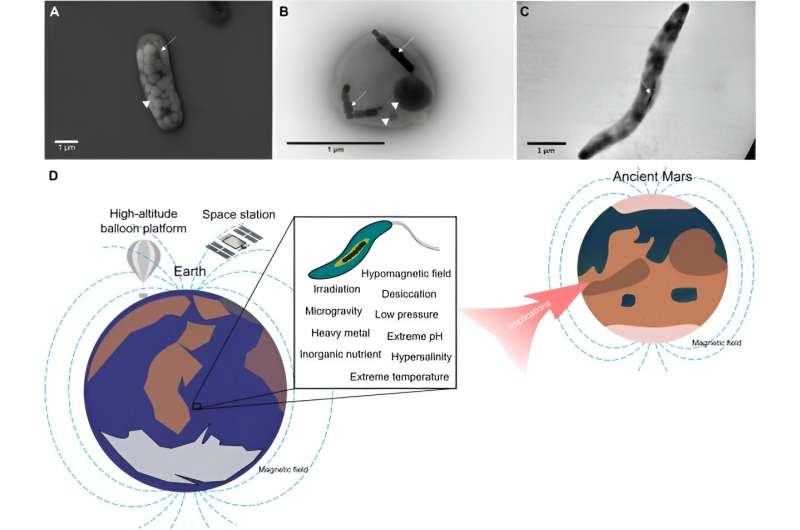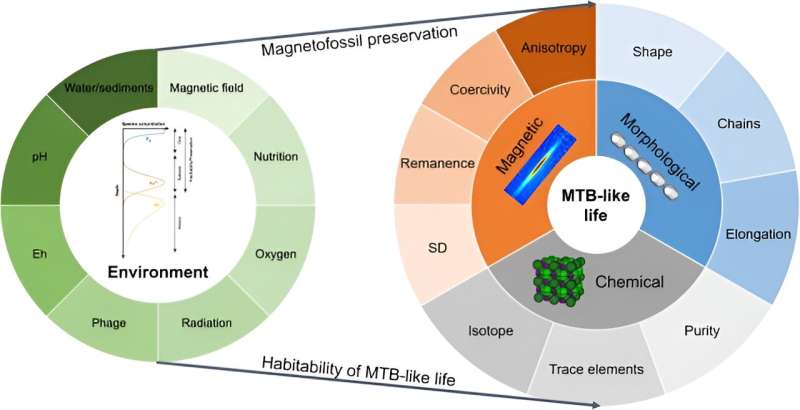October 2, 2023 feature
This article has been reviewed according to Science X's editorial process and policies. Editors have highlighted the following attributes while ensuring the content's credibility:
fact-checked
peer-reviewed publication
trusted source
proofread
Renaissance for magnetotactic bacteria in astrobiology

Magnetotactic bacteria can form magnetofossils like magnetic nanocrystals as observed in the Martian meteorite ALH84001, which held a special place in the field of astrobiology primarily in the early 90s. While the flourishing of interest in magnetotactic bacteria has waned over time, a resurgence of magnetosome formation has led to a renaissance of magnetotactic bacteria (abbreviated as MTB) in astrobiology.
Astrobiologists have detected such MTBs living in naturally extreme environments with wide-ranging salinity, temperature, and pH ranges. Some MTB populations can survive extreme extraterrestrial conditions simulated by using simple, inorganic compounds such as sulfate and nitrate. These microorganisms are a model representing astrobiologically ancient Martian life, if it ever occurred to form magnetotactic microorganisms.
In a new report in The ISME Journal, Jianxun Shen and a team of scientists in Earth and planetary physics, ocean and ecological sciences, and geological and planetary sciences at the California Institute of Technology, U.S., University of Liverpool, U.K., and the Chinese Academy of Sciences, China, summarized multiple typical biosignatures that can be applied to detect ancient-MTB on Earth, alongside their extraterrestrial MTB-like counterparts.
Such lifeforms can be transported to space stations and simulation chambers to explore their tolerance potential and distinct biosignatures to aid the evolution of magnetotactic bacteria and their potential as an extraterrestrial biomarker.
The origin of magnetotactic bacteria and their presence on Mars
In 1984, a team of researchers discovered a Martian meteorite, Allan Hills 84001, in the Allan Hills region of Antarctica. They then obtained its potential relic biogenic activity in 1996. The meteorite contained microscopic "disk-like" carbonite particles embedded with nanocrystalline magnetites with chemical and physical properties similar to magnetotactic bacteria (MTB). Shen and colleagues explored prospects of this highly interdisciplinary and significant field of functional magnetotactic bacteria in astrobiology.
The microorganisms are armed with flagellar motility for cells to migrate along magnetic field lines. Magnetosomes are membrane-bound crystals composed of magnetite and greigite crystals. Their origin suggests that they are among the most ancient prokaryotes on Earth.
The intracellular iron-mineral particles of the microorganisms have an excellent trace in the geological record and are known as magnetofossils. Magnetotactic bacteria possess a variety of phenotypes to survive in a wide range of planetary analog environments. As the first type of magneto sensitive and biomineralizing organisms, the bacteria are assumed to have co-evolved on Archean Earth. Due to the similarities between Mars and early Earth, the emergence of MTB-like life on Mars is an intriguing possibility that requires further investigation.

Stress tolerance of magnetotactic bacteria to survive interplanetary travel
Magnetotactic bacteria have widespread habitats where different strains exhibit sensitivity to different stress factors, nutrients and oxygen levels. The microorganisms can further tolerate natural extreme environments for high salinity tolerance, extreme pH tolerance, extreme temperature tolerance, and survive Mars-like settings on Earth.
For instance, hours of exposure to the lower near-space environment led to the survival of the wild-type Magnetospirillum gryphiswaldense strain, to highlight the capacity of magnetotactic bacteria to survive interplanetary travel, to take terrestrial life to other astronomic bodies, or bring extraterrestrial life from sources to the prebiotic Earth.
Withstanding simulated extreme environments
Shen and team explored the possibilities of recreating natural extreme environments in the lab, as artificially simulated conditions to provide valuable insights to regulate environmental factors. To test these factors, they analyzed radiation tolerance, hypomagnetic field, low gravity environments, and heavy metal stress to show the capacity of magnetotactic bacteria to withstand/tolerate heavy-metal rich environments and other simulated conditions.
The scientists used morphological microstructures or micro-texture biosignatures to support further findings of magnetosome-like nanostructures that favor magnetotactic-like life, while preserving magnetofossils.
During the search for key factors in MTB-like biosignatures, they studied morphological biosignatures, magnetic biosignatures, isotropic biosignatures, trace element and biogeochemical biosignatures, as well as phage-infection biosignatures to highlight the potential for viruses to have co-existed with organisms in the history of life on Earth.
Outlook
In this way, Jianxun Shen and colleagues studied magnetotactic extremophiles to understand potential life-forms on early Earth and other astronomical bodies with strong magnetic fields and aquatic settings. To understand the role of magnetotactic bacteria, the team explored them in simulated environments with early Earth-like and Mars-like extreme environments.
They suggest transporting a few MTB strains to space environments on the Tiangong Space Station, the International Space Station, or space environmental simulation chambers to study their survival under Mars-like or other extraterrestrial conditions. The scientists propose a range of additional experiments in biogeomagnetism for exciting and practical investigations by integrating advanced scientific equipment.
More information: Jianxun Shen et al, Renaissance for magnetotactic bacteria in astrobiology, The ISME Journal (2023). DOI: 10.1038/s41396-023-01495-w
Wei Lin et al, Origin of microbial biomineralization and magnetotaxis during the Archean, Proceedings of the National Academy of Sciences (2017). DOI: 10.1073/pnas.1614654114
Journal information: Proceedings of the National Academy of Sciences , ISME Journal
© 2023 Science X Network





















